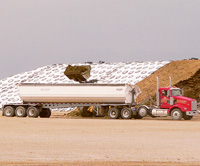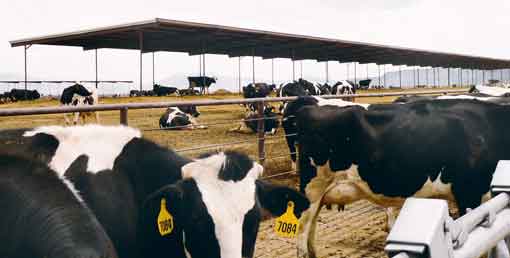Large-scale dairy: High pregnancy rates

Feeding a consistent diet is fundamental to achieving good body-condition score and high fertility rates in heifers, according to Bill Millenkamp of Millenkamp Cattle, Jerome, Idaho.
At East Valley Cattle, Malta, Idaho, 40,000 heifers are reared in open lots from about five months up until 18 months.
“Our feed has got to be well mixed and uniform to achieve results.” And on such a large scale, TMR mixing has to be carried out using a feed mill and side tipping trucks.
The unit feeds a forage-based diet, including whole-crop silage, haylage, alfalfa and sugar beet, with 100 loads going out a day and 10,000t of hay used a month.
The feeding here is exceptional, with feed in front of animals 24/7, says Luke Wood, RMS technician.
“But you do see a marked drop in fertility when the diet is switched from second- to third-cut silage.”
| Idaho videos |
|---|
|
Find out what UK dairy farmers think we could learn from large-scale units in the USA, and their answer to the question “Do you think high cow numbers means low cow welfare?” here You can also read what consultants and US farmers thought. |
It’s all about sourcing quality feed, explains Genus’s John Cook. “Body condition has a huge influence on fertility – when too much starch is included in the diet, heifers will put on too much condition, stimulating liver blood flow and metabolising fertility hormones.”
Culling
Culling out poor heifers is all part of maintaining high fertility at East Valley Cattle, explains Mr Millenkamp.
“I assess all breeding heifers and pick out which to use for breeding and which to go for beef – the dairies may lose $100-$200 (£69-£138) an animal, but it is good practice to stop these poor animals entering the main milking herd.”
Ovsynch/presynch programmes
Most large scale dairy units visited in Idaho were implementing strict ovsynch/presynch mating programmemes to give all cows and heifers the best chance of getting in calf.
Large herds need to be proactive when it comes to fertility, says John Cook of Genus ABS.
“By using hormone treatments at appropriate times on appropriate cows, you are essentially creating ‘pregnancy traps’.”
At Double A Dairy, the presych programme involves three prostaglandin injections, 14 days apart, with the third prostaglandin administered on day 58 post-calving, explains John Andersen, Double A Dairy manager.
“With a voluntary waiting period of 60 days, about 75% of cows are bred off their third prostaglandin injection, achieving 40% conception rates.”
Presynch is designed so that as many cows as possible are cycling when they finish the voluntary waiting period, explains Mr Cook.
“Cycling cows will then express natural heats, so farm staff will aggressively heat-detect – the first level of ‘pregnancy traps’ is always heat detection.”
The last presynch shot is given two days before the end of the voluntary waiting period and then staff heat-detect for 14 days.
“At the end of the 14 days, anything not expressing heat is probably not going to, so they are enrolled on the ovsynch programmeme.”
On day zero of ovsynch, the first gonadotropin-releasing hormone (GnRH) injection is given and a progesterone CIDR is put in if the farm is following a CIDR synch/ovsynch programmeme – although this is not essential.
At day seven a prostaglandin injection is given and the CIDR pulled out. Two days later another GNRH injection is given and, 24 hours later, these cows are served blind.
Before using a CIDR, conception rates were about 25%. Now they are 35%, says Mr Andersen.
“On ovsynch days we may have 120 cows to breed, so having two permanent ABS inseminators on site is essential,” he says.
“ABS staff are part of the team; they walk, chalk and inseminate cows and are the reason we have such a successful breeding programme.”
Double A is achieving an average 21% pregnancy rate, 38% conception rate and 65% heat detection.
Fresh-calved cows
The lifeblood of any dairy is the fresh calved cow, says Phil Salkeld of ABS UK and EU technical services. “How you manage the fresh cow dictates her reproductive health for the rest of her lactation.
“It is essential cows transition well to ensure fertility is right – follicles develop 60 days before ovulation so, when cows are not treated straight away, they will continuously produce a cycle of poor follicles.”
Temperature challenge
In Idaho, temperature can range dramatically, with summer highs of more than 40C, dropping to -12C in the winter.
This creates fertility challenges on both open-lot and housed systems, with most farms experiencing drops in pregnancy rates during summer.
At Double B Dairy, where 10,500 cattle are outside on open dirt lots, pregnancy rates have been known to drop from 24% in spring to less than 18% in summer, explains Kent Olmos, reproductive programme manager, ABS Global.
“As a result, we advised misters and coolers to keep pregnancy rates above 20%.”

Shades are positioned facing north-to-south at an angle of no more than 30° to maximise the shaded area provided. Straw is also moved under the shades to act as a heat sink and encourage cows to lie.
